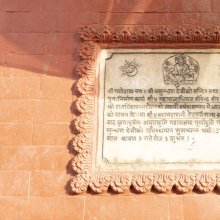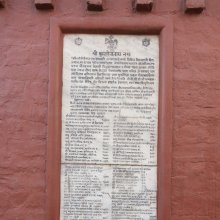Maharajadhiraja, Mahārājādhirāja, Mahārājadhirāja: 5 definitions
Introduction:
Maharajadhiraja means something in Hinduism, Sanskrit, the history of ancient India. If you want to know the exact meaning, history, etymology or English translation of this term then check out the descriptions on this page. Add your comment or reference to a book if you want to contribute to this summary article.
Images (photo gallery)
India history and geography
Source: Cologne Digital Sanskrit Dictionaries: Indian Epigraphical GlossaryMahārājādhirāja.—(IE 8-2; EI 3; CII 3, 4), one of the technical titles of paramount sovereignty closely connected with Paramabhaṭṭāraka and Parameśvara; later sometimes also assumed by subordinate rulers. Note: mahārājādhirāja is defined in the “Indian epigraphical glossary” as it can be found on ancient inscriptions commonly written in Sanskrit, Prakrit or Dravidian languages.

The history of India traces the identification of countries, villages, towns and other regions of India, as well as mythology, zoology, royal dynasties, rulers, tribes, local festivities and traditions and regional languages. Ancient India enjoyed religious freedom and encourages the path of Dharma, a concept common to Buddhism, Hinduism, and Jainism.
Languages of India and abroad
Sanskrit dictionary
Source: Cologne Digital Sanskrit Dictionaries: Shabda-Sagara Sanskrit-English DictionaryMahārājādhirāja (महाराजाधिराज).—m.
(-jaḥ) A paramount sovereign, an emperor. E. mahārāja, adhirāja chief sovereign.
Source: Cologne Digital Sanskrit Dictionaries: Monier-Williams Sanskrit-English DictionaryMahārājādhirāja (महाराजाधिराज):—[=mahā-rājādhirāja] [from mahā-rāja > mahā > mah] m. a paramount sovereign, emperor, [Kādambarī]
Source: Cologne Digital Sanskrit Dictionaries: Yates Sanskrit-English DictionaryMahārājādhirāja (महाराजाधिराज):—[mahā-rājā-dhirāja] (jaḥ) 1. m. An emperor.
[Sanskrit to German]
Sanskrit, also spelled संस्कृतम् (saṃskṛtam), is an ancient language of India commonly seen as the grandmother of the Indo-European language family (even English!). Closely allied with Prakrit and Pali, Sanskrit is more exhaustive in both grammar and terms and has the most extensive collection of literature in the world, greatly surpassing its sister-languages Greek and Latin.
See also (Relevant definitions)
Partial matches: Maha, Dhiraja, Rajadhiraja, Maharaja.
Starts with: Maharajadhiraja-parameshvari, Maharajadhiraja-pati.
Ends with: Dharma-maharajadhiraja.
Full-text: Maharajadhiraja-pati, Maharajadhiraja-parameshvari, Siddhantasarapaddhati, Maharajadhi, Varanaka, Maharaja, Vatsaraja, Paramabhattaraka, Rajavali, Kamasiddhi, Vamakeshvari, Kamasiddhistuti, Vamakeshvaristuti, Candravarman, Sanchor.
Relevant text
Search found 15 books and stories containing Maharajadhiraja, Mahārājādhirāja, Maha-rajadhiraja, Mahā-rājādhirāja, Maharaja-dhiraja, Mahārājā-dhirāja, Mahārājadhirāja; (plurals include: Maharajadhirajas, Mahārājādhirājas, rajadhirajas, rājādhirājas, dhirajas, dhirājas, Mahārājadhirājas). You can also click to the full overview containing English textual excerpts. Below are direct links for the most relevant articles:
Harshacharita (socio-cultural Study) (by Mrs. Nandita Sarmah)
Part 5: Royal Titles < [Chapter 5 - Political Aspects]
A Historical Study of Kaushambi (by Nirja Sharma)
Impact of Vedic Culture on Society (by Kaushik Acharya)
Changes in Administration and Polity in Later Vedic Era < [Chapter 5]
Sanskrit Inscriptions (L): The Candella < [Chapter 3]
Mingling of Cultures (X): The Candellas < [Chapter 4]
The history of Andhra country (1000 AD - 1500 AD) (by Yashoda Devi)
Part 5 - Gonka III (A.D 1181—1185) < [Chapter I - The Velanandu Chodas of Tsandavole (A.D. 1020-1286)]
Part 11 - Samrnapanideva or Sarngapani (A.D. 1267) < [Chapter XIV - The Yadavas]
Part 1 - Gonka I (A.D. 1076-77—1106-7) < [Chapter I - The Velanandu Chodas of Tsandavole (A.D. 1020-1286)]
Stupas in Orissa (Study) (by Meenakshi Chauley)
During the Gupta period < [Chapter 2]
Jain Remains of Ancient Bengal (by Shubha Majumder)
Images of Tīrthaṅkara Suvidhinātha or Puṣpadanta < [Chapter 6 - Iconographic Study of Jaina Sculptural Remains]
Images of Tīrthaṅkara Candraprabha (Introduction) < [Chapter 6 - Iconographic Study of Jaina Sculptural Remains]
Archaeological sites in Burdwan (Sadar North and Sadar South) < [Chapter 4 - Distribution of Sites Yielding Jaina Remains]


